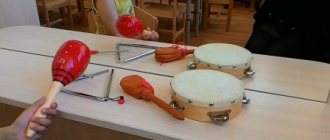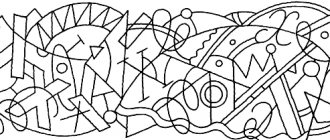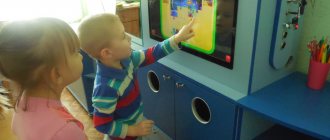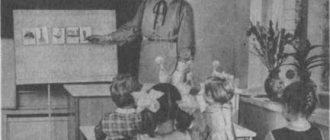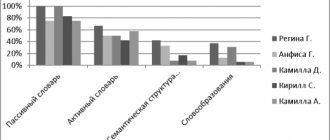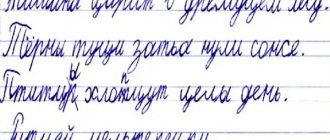Peculiarities of perception in speech disorders material on speech therapy on the topic
Peculiarities of perception in speech disorders
Violations of phonemic perception are noted in all children with speech disorders, and there is an undoubted connection between disorders of the speech-auditory and speech-motor analyzers. It is known that dysfunction of the speech motor analyzer in dysarthria and rhinolalia affects the auditory perception of phonemes (G.F. Sergeeva, 1973). At the same time, there is not always a direct relationship between disturbances in the pronunciation of sounds and their perception.
Children with speech disorders have specific difficulties in distinguishing subtle differentiated features of phonemes, which affect the entire course of development of the sound side of speech. They can have a secondary influence on the formation of sound pronunciation.
Such defects in children's speech, such as the use of diffuse sounds of unstable articulation, distortion of sounds correctly pronounced outside speech in an isolated position, numerous substitutions and confusions with a relatively formed structure and function of the articulatory apparatus, indicate a primary immaturity of phonemic perception.
Sometimes such children demonstrate auditory discrimination of those phonemes that are not contrasted in pronunciation, while in other cases, those phonemes that are differentiated in pronunciation are not distinguished either. Nevertheless, there is a certain proportionality here: the greater the number of sounds differentiated in pronunciation, the more successfully the phonemes are distinguished by ear. And the fewer “supports” there are in pronunciation, the worse the conditions for the formation of phonemic images. The development of phonemic hearing itself is in direct connection with the development of all aspects of speech, which, in turn, is determined by the general development of the child.
The study of visual perception allows us to draw conclusions that in preschool children with speech pathology this mental function lags behind the norm and is characterized by insufficient formation of a holistic image of an object (E.M. Mastyukova). Research shows that simple visual recognition of real objects and their images does not differ from the norm in these children.
Difficulties appear when tasks become more complex (recognition of objects in conditions of overlap, noise). Thus, children with ODD perceive the image of an object in complicated conditions with certain difficulties: the time of decision-making increases, children are not confident in the correctness of their answers, identification errors are noted, the number of which increases with a decrease in the number of informative features of objects.
In implementing the task of perceptual action (trying on a standard), children in this category more often use elementary forms of orientation, i.e. by trying on a standard, in contrast to children with normal speech, visual correlation is predominantly used. Children with ODD often, when trying on figures, are guided not by their shape, but by color. Moreover, boys often have lower results than girls.
When studying visual perception in children of primary school age with mental retardation, dysarthria and speech disorders of the alalia type, the following gnostic functions were studied: optical-spatial gnosis, spatial representations, facial gnosis, finger and oral stereognosis (the ability to perceive, recognize objects in a tactile-motor way, to the touch) (L.S. Tsvetkova, T.M. Pirtskhalaishvili, 1975).
Violations of optical-spatial gnosis are considered characteristic of children with organic brain damage. As a result of its study using L. Bender’s methodology, as well as during observations of the activities of children with speech pathology in the process of drawing, designing and learning to read and write, it was revealed that this function in children of primary school age, in comparison with normally developing peers, is at a much lower level.
The dynamics of development of spatial perception are most favorable in children with mental retardation, and least favorable in children with alalia. The degree of violation of optical-spatial gnosis also depends on the insufficiency of other processes of perception, especially the formation of spatial representations.
The perception of space is currently considered as the result of the joint activity of various analyzers.
In this case, important importance is given to the normal functioning of the parietal parts of the brain. The most distinct spatial impairments are observed in students of preparatory and first grades of speech schools.
Spatial disturbances are especially persistent in human drawing: the image is characterized by poverty, primitiveness and a small number of details, as well as the presence of specific optical-spatial disturbances (in children with alalia). However, spatial impairments in children with speech disorders are characterized by a certain dynamism and a tendency towards compensation.
A significant role of spatial disorders is seen in the severity and persistence of written language disorders (dyslexia and dysgraphia), and counting disorders that can be observed with speech disorders. Studies of the ability to establish spatial relationships between phenomena of reality in objective-practical activities and understand them in impressive speech indicate the preservation of these abilities. But in expressive speech, children with severe speech pathology often do not find linguistic means to express these relationships or use incorrect linguistic means. This is due to a disruption in their processes of recoding a preserved semantic program into a linguistic form.
Studies of facial gnosis (using the Tardieu technique) show a relationship between its impairments (especially in the area of oral muscles) and the severity of sound pronunciation disorders. Thus, the most pronounced violations of facial gnosis are characteristic of children with dysarthria and alalia.
Impairments of oral and digital stereognosis were studied using general methods described in the domestic literature, as well as using the method of R.L. Ringel, when the child was asked to determine the shape of objects placed in his mouth. The most pronounced disturbances were observed in children with the most severe deficiencies in expressive speech (especially in children with alalia and dysarthria, when their phonetic aspects of speech were severely impaired).
Significant impairments in oral stereognosis are also observed in children with severe impairments in facial gnosis. No impairments of finger stereognosis were identified in children with speech disorders.
Other studies also indicate a lag in the development of visual perception and object-based visual images in children with various forms of dysarthria and mental retardation in the absence of primary intellectual impairment. It has been revealed that visual impairments in children with severe speech pathology manifest themselves mainly in poverty and undifferentiation of visual images, inertia and fragility of visual traces, as well as in the absence of a strong and adequate connection between the word and the visual representation of the object. Preschool children with speech pathology are more likely to be impaired in visual perception and object-based visual images and, to a lesser extent, in visual operative memory, which is grossly impaired in children with intellectual disabilities, although this group of children suffers less from visual perception.
These provisions indicate that the sensory development of a child with speech impairments is significantly behind in terms of development and is extremely uneven.
Diagnosis of perception disorders
When diagnosing perception disorders, we can distinguish several levels of development of speech understanding in children with ODD.
1. Zero: a child with intact hearing does not perceive the speech of others, sometimes reacts to his name, less often to intonations of prohibition or encouragement.
2. Situational: the child understands requests related to the everyday objective world, knows the names of loved ones and the names of his toys, can show parts of the body in himself, in his parents, in a doll, but does not distinguish, based on a verbal request, images of objects, toys that are well known to him in his life. everyday life
3. Nominative: the child is well versed in the names of objects depicted in individual pictures, but has difficulty understanding the names of actions depicted in plot pictures (walking, sitting, reading). He does not understand questions of indirect cases at all (with what? to whom? with whom?).
4. Predicative: the child knows many names of actions, easily navigates questions of indirect cases posed to objects of actions depicted in plot pictures, distinguishes the meanings of several primitive prepositions (put on the box, in the box, near the box). Does not distinguish between grammatical forms of words.
5. Dissected: the child distinguishes changes in meanings introduced by individual parts of the word (morphs) - inflections, prefixes, suffixes (“table - tables”, “flew away - flew in”).
Before examining speech perception, it is necessary to familiarize yourself with the results of a child’s physical hearing test. It has been established that even a slight decrease in hearing acuity in early childhood leads to the inability to distinguish speech sounds and pronounce them clearly. The presence of normal hearing acuity is an important condition for the formation of phonemic perception.
It is also necessary to observe how the child controls his pronunciation and how much he is able to distinguish whether the word form presented to him is correct. With underdevelopment of phonemic perception, children whose pronunciation contains sound substitutions do not notice pronunciation deficiencies in other people’s speech. To diagnose the characteristics of perception in children with speech impairments, a set of techniques is used.
For many years, the problem of the development of perception properties has been the subject of scientific research by many psychologists and educators. Perception is a person’s reflection of an object or phenomenon as a whole with its direct impact on the senses. Human perception is distinguished not only by its integrity, it creates, by and large, an image of the world, and not just the current situation. The image of the world always contains components that do not currently meet any needs of the body or personality. The mental image is created “with reserve”. In addition to sensations, perception involves previous experience and processes of understanding what is perceived. Thus, a complete human perceptual system is created. Problems of perception have always been of interest to many foreign and domestic researchers and scientists, among whom were S.L. Rubinshtein, L.A. Wenger, A.V. Zaporozhets, V.P. Zinchenko, T.V. Lavrentieva, E.N. Sokolov , K.V. Tarasova, V.V. Yurtaikin and others.
The topic of our research is the features of perception properties in children with speech impairments. L.S. has repeatedly pointed out the enormous importance of speech for the development of thinking and personality formation. Vygotsky, who wrote: “The development of oral speech is probably the most convenient phenomenon in order to trace the mechanism of behavior formation and compare the approach to these phenomena, typical of the doctrine of conditioned reflexes, with the psychological approach to them. The development of speech represents, first of all, the history of how one of the most important functions of a child’s cultural behavior is formed, which lies at the basis of the accumulation of his cultural experience.”
At the same time, much attention is paid to the problems of the properties of perception in normal conditions and in pathology, and its types. This mental process is also being studied in people with speech disorders. The number of children with speech disorders increases every year. According to the World Health Organization, in economically developed countries, about 20% of people have speech impairment. Features of the properties of perception in children with speech impairment were studied by L.A. Venger, R.A. Granit, A.V. Zaporozhets, V.P. Zinchenko, T.S. Komarova and others. This problem is very relevant today.
The purpose of the study is to identify the features of the development of perception properties in children with speech impairment.
The object of the study is the process of development of perceptual properties in children with speech impairment.
The subject of the study is children with speech impairment.
The subject of the research is means and methods for studying and identifying the properties of perception in children with speech impairment.
Research objectives:
- To study scientific psychological and pedagogical literature on the problem of development of perceptual properties in children with speech impairment.
- To study the features of the development of perception properties in children with speech impairment.
- To select methods for diagnosing the characteristics of perception properties in children with speech impairment.
- To identify existing correctional techniques for the development of perceptual properties in children with speech impairment.
- To develop recommendations for teachers and parents on shaping the development of perceptual properties in children with speech impairment.
This work is devoted to the study of the properties of perception in children with speech impairment. As a result of long and painstaking work, theoretical and practical analysis of the study, it was revealed that perception is a reflection in the human mind of objects and phenomena that directly affect his senses as a whole, and not of their individual properties, as happens with sensation. Perception is not the sum of sensations received from this or that object, but a qualitatively new level of sensory cognition with its inherent abilities. The purpose, object and subject of the study, tasks were established, and the main characteristics and features of perception properties in children with speech impairment were also described.
To diagnose the properties of perception in children with speech impairment, on December 1, 2014, experimental work was carried out using the following methods: “Recognition of crossed out images” Semago N.Ya., Semago M.M., “Recognition of superimposed images (Poppelreitor figures)” Semago N. Ya, Semago M.M., “Recognition of unfinished images” Semago N.Ya, Semago M.M. and “Holistic perception of familiar objects” by T.N. Golovina. Five pupils of the preparatory group of MBDOU No. 21 in the village of Konokovo, Uspensky district were selected.
Participants in the experiment: Maxim R. (02/13/2008), conclusion of the PMPC - ONR, Samvel K. (05/23/2008), conclusion of the PMPC - ONR, Armen A. (11/4/2008), conclusion of the PMPC - ONR, Veronica G. ( 09/17/2008) and Kirill S. (08/09/2008) with normal speech. For diagnosis, methods proposed by Semago N.Ya, Semago M.M. were used. and Golovina T.N.
By studying the properties of perception in children with speech impairments, the level and norm of mental development were identified, and the development of the properties of perception in children with speech impairments was studied. First, the causes of speech disorders, their classifications, types, and the development of perception in normal and pathological conditions were considered. Various types and types of perception were also studied, but more attention was paid to the six main properties of this mental process: objectivity, integrity, generality, constancy, meaningfulness and selectivity. From a huge number of methods, the following were chosen: three methods by Semago N.Ya. and Semago M.M. “Recognition of under-drawn images”, “Recognition of superimposed images (Poppelreitor figures)”, “Recognition of crossed-out images” and the technique of T.N. Golovina. “Integral perception of familiar objects”, the purpose of which is to identify the characteristics of perception properties in children with speech impairment and their possible correction.
An analysis of experimental work has shown that the problem of the development of perceptual properties in preschool age is significant. The results obtained showed that in preschool age elements of integrity and objectivity are formed on the basis of the development of speech and other cognitive processes. Often, such a property of perception as generalization is still imperfect in many children of primary school age. At the same time, it is generalization that predetermines the formation of other mental cognitive processes - memory, representation, speech, thinking. Generality connects a person’s individual and social experience, providing semantic constancy. Unfortunately, the operations of generalization and classification in children of this age are still only in the formative stage, which can affect not only the child’s academic performance, but also his ability to assimilate the norms and requirements of adults. Even when perceived, they may remain inaccessible in their meaning.
Different people’s perception of their defective speech can be complete or incomplete, deep or superficial, accurate or erroneous. This will only determine the different attitudes of children with speech impairments to their defect and the need for a differentiated (individual) approach to their psychological study and correctional work.
So, we can say that speech disorders influence the formation of higher mental functions of a person, including perception, and the properties of perception develop a child’s holistic understanding of the world around him.
Features of attention, perception, memory, speech and thinking in children with mental retardation
The article is based on the experience that child psychologists have; it will help you develop the right tactics when working with such children.
About attention
It should be understood that such children are quite distracted in class; they are not able to work for more than ten to fifteen minutes. Children with mental retardation have reduced attention to verbal information, even when the story is very exciting and interesting. A child may lose the thread of a question or story even with the slightest irritation, for example, when there is a knock on the door.
A specific feature in the formation of attention in a child with mental retardation is that, taking into account the structure of the defect, attention deficit can be divided into two areas.
- When the leading factor in the structure of the defect is dysregulation.
Children from this group suffer from impulsiveness, unstable attention, and exhaustion, which are combined with fairly high processes in cognitive activity (visual-figurative and verbal-logical thinking, memory).
When correcting in this group, it is necessary to dose tasks over time, as well as use techniques that contribute to the development of self-control, the formation of voluntary attention, etc.
- When the leading factor in the structure of the defect is the underdevelopment of cognitive processes, which are combined with a slow pace of activity, short-term memory and a narrower scope of attention when performing various tasks. In this group of children, the formation of voluntary attention should be carried out in conjunction with the development of speech and thinking.
Memory
Children with mental retardation have a memory that is qualitatively unique. In such children, first of all, the strength of memorization is reduced and the memory capacity is limited. They are characterized by rapid loss of information and inaccurate reproduction. Verbal memory suffers the most. The severity of this defect may depend on the origin of the developmental defect. With a competent approach to learning, children are able to assimilate some mnemonic techniques, as well as master logical methods of memorization. Per unit of time, children with mental retardation perceive a smaller proportion of information.
Features of perception:
— Limited, insufficient, fragmented knowledge about the world around us;
— The integrity of perception suffers. The disturbance concerns not only individual properties of perception, but also perception as an activity;
— Structurality and objectivity are impaired (difficulty is noted in recognizing objects from an unusual perspective, the child recognizes and mixes elements of letters and letters that are similar in outline);
— Indicative research activities, which are aimed at studying the qualities and properties of objects, are hampered;
— Such children are characterized by passivity of perception (a more complex task is replaced by a simple one), and difficulties in orienting themselves in space.
— A greater number of fittings and practical tests are needed when solving visual and practical problems; children have difficulty examining the subject.
“Children can practically correlate objects by size, shape, color, but their sensory experience is not generalized for a long time and is not consolidated in words. There are errors when naming the size, color or shape. Because of the above, reference views are not formed in a timely manner.
— When naming primary colors, the child finds it difficult to name intermediate color shades. Does not use words that denote quantities (“wide-narrow”, “short-long”, “low-high”, etc.), but uses the words “small-large”.
— deficiencies in sensory and speech development influence the formation of the area of images and representations.
- due to weakened analyzing perception, the child has difficulty identifying the main components of objects and determining their relative location in space.
— There is a slow pace in the formation of the ability to perceive holistic images of objects.
- deficit of tactile-motor perception, expressed in unsatisfactory differentiation of tactile and kinesthetic sensations (material texture, temperature, size, shape, surface properties); the child has difficulty recognizing objects by touch.
- slowing down the process of formation of inter-analyzer connections that underlie complex activities. Deficiencies in auditory-visual-motor and visual-motor coordination.
Thinking
Lag at the level of visual forms of thinking:
— Difficulties appear in the formation of the sphere of images and representations;
— Lack of development of the ability to creatively create new images;
— The imitative nature of the activities of children with mental retardation was noticed;
— Slowdowns in the process of formation of mental operations.
Upon reaching senior preschool age, children with mental retardation do not develop a level of verbal and logical thinking that corresponds to age-related capabilities:
The child does not highlight essential features when generalizing, but generalizes according to functional or situational features.
- Children find it difficult to compare objects, comparing them according to random characteristics, and they also find it difficult even when looking for signs of difference. But preschoolers with mental retardation, after receiving help, perform the proposed tasks at a higher level, which is close to the norm.
The majority of children with mental retardation have a normal level of development of visual-effective thinking. They complete the task correctly, but some need a stimulating task. Visual-figurative thinking: most of these children need repeated repetition of the task, as well as the provision of certain types of assistance, but there are also children for whom help does not help them cope with the task. Most people have not developed verbal-logical thinking.
Depending on the development of thinking and characteristics of children with mental retardation, they can be divided into three groups:
- Children have normal development of mental operations, but their cognitive activity is reduced.
- Children with uneven manifestations of cognitive activity and productivity in completing tasks.
- The child has a combination of lack of cognitive activity and low level of productivity.
Speech (secondarily impaired)
Speech disorders are systemic in nature and are included in the structure of the defect.
— The impressive side of speech is characterized by insufficient differentiation of the perception of shades of speech and speech sounds.
— The expressive side of speech is characterized by a poor vocabulary (speech consists of verbs and nouns).
— There is a violation in sound pronunciation, the lexical and grammatical side of speech is not richly formed (flowers instead of a flowerbed, a glass is a mug, the child mixes words of different meanings, but similar in sound composition: train-belt; does not catch the difference: sews - embroiders, uses words in an inaccurate manner , approximate meaning: tree-garden, hat-hat, replaces the name with an action or description of an object), defects of the articulatory apparatus, the presence of agrammatisms.
